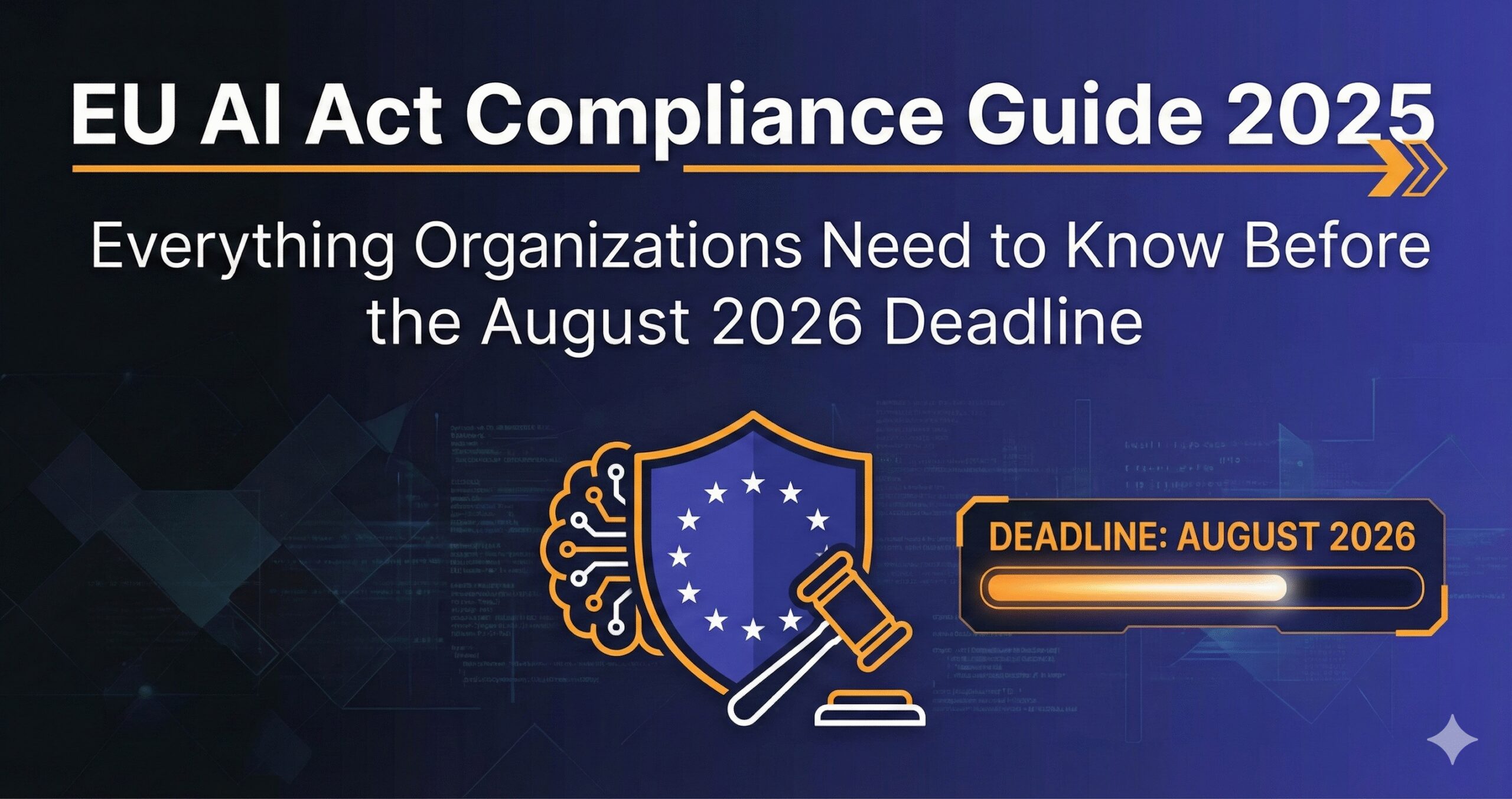
Photo by Google DeepMind via Pexels
Introduction: The EU AI Act Is Here—Are You Prepared?
The European Union’s Artificial Intelligence Act (EU AI Act) represents the world’s first comprehensive AI regulation framework, and it’s rapidly becoming operational. With key compliance deadlines approaching in 2025 and full implementation by August 2, 2026, organizations deploying AI systems in Europe face critical decisions and substantial compliance obligations.
This comprehensive guide breaks down everything organizations need to know about EU AI Act compliance, from classification requirements to implementation strategies, helping you navigate what the European Commission calls “the world’s most ambitious attempt to regulate artificial intelligence.”
Latest Development: In November 2025, the European Commission announced proposed reforms to simplify compliance requirements while maintaining robust protections, signaling both the EU’s commitment to effective AI governance and recognition of implementation challenges.
What Is the EU AI Act? Understanding Europe’s Landmark AI Regulation
The EU AI Act, officially adopted in 2024 and entering force progressively through 2026, establishes a risk-based regulatory framework for artificial intelligence systems deployed within the European Union or affecting EU citizens.
Core Principles of the EU AI Act
The legislation operates on several foundational principles:
- Risk-Based Classification: AI systems are categorized by potential harm—prohibited, high-risk, limited risk, or minimal risk
- Transparency Requirements: Users must know when interacting with AI systems
- Human Oversight: High-risk AI requires meaningful human supervision
- Technical Documentation: Comprehensive records of AI system development and deployment
- Conformity Assessment: Independent evaluation before market deployment
Why the EU AI Act Matters Globally
Despite being European legislation, the EU AI Act has extraterritorial implications similar to GDPR:
- Global Reach: Applies to non-EU companies whose AI systems are used in Europe
- Standard Setting: May become the de facto global AI regulatory standard
- Competitive Impact: Compliance demonstrates market access and regulatory sophistication
- Supply Chain Effects: Downstream users must ensure their AI vendors comply
Organizations operating globally increasingly treat EU AI Act compliance as a baseline requirement rather than a regional consideration.
EU AI Act Compliance Timeline: Critical 2025-2026 Deadlines
Understanding the phased implementation timeline is crucial for prioritizing compliance efforts:
Immediate Restrictions (February 2025)
Prohibited AI practices became enforceable six months after the Act entered force. Organizations must immediately cease:
- Social scoring systems by government authorities
- Emotion recognition in workplace and educational settings
- Biometric categorization systems using sensitive characteristics
- Untargeted scraping of facial images for facial recognition databases
- AI systems exploiting vulnerabilities of specific groups
August 2025: General-Purpose AI Model Requirements
Obligations for General-Purpose AI (GPAI) models take effect, including:
- Technical documentation requirements
- Transparency about training data
- Energy consumption disclosure
- Compliance with EU copyright law
- Systemic risk assessments for high-capacity models
August 2, 2026: Full High-Risk AI System Compliance
The comprehensive high-risk AI system requirements become fully enforceable, requiring:
- Complete conformity assessments
- CE marking for compliant systems
- Registration in the EU AI database
- Ongoing monitoring and reporting systems
- Quality management system implementation
High-Risk AI Systems: Classifications and Requirements
The EU AI Act’s most stringent requirements apply to high-risk AI systems—those with significant potential to harm health, safety, or fundamental rights.
What Qualifies as High-Risk AI?
High-risk designation applies to AI systems in these categories:
1. Critical Infrastructure
- AI managing energy, water, gas, or transport safety systems
- Systems controlling essential service provision
2. Education and Vocational Training
- AI determining educational institution access
- Student assessment and evaluation systems
- Examination grading algorithms
3. Employment and Worker Management
- Recruitment and candidate screening AI
- Task allocation and performance monitoring
- Promotion and termination decision support
4. Essential Private and Public Services
- Credit scoring and creditworthiness assessment
- Emergency response dispatching systems
- Public benefit eligibility determination
5. Law Enforcement
- Predictive policing algorithms
- Evidence reliability assessment
- Crime detection and investigation support
6 Critical Steps for EU AI Act Compliance Before August 2026
Based on guidance from the European Commission and leading compliance experts:
Step 1: AI System Inventory and Classification
- Identify: Catalog all AI systems currently deployed or in development
- Classify: Determine risk level (prohibited, high-risk, limited, minimal)
- Prioritize: Focus resources on prohibited and high-risk systems first
- Document: Create detailed records of each system’s purpose and function
Step 2: Gap Analysis and Impact Assessment
- Compare current practices against EU AI Act obligations
- Document areas of non-compliance or uncertainty
- Estimate costs, timelines, and personnel needs
- Address highest-risk gaps first
Step 3: Governance Framework Implementation
- Designate compliance officers and responsible teams
- Create AI governance policies aligned with EU AI Act
- Educate technical and business teams on requirements
- Ensure third-party AI providers meet standards
Step 4: Technical Compliance Implementation
- Implement technical documentation platforms
- Deploy continuous risk monitoring infrastructure
- Establish data quality and bias detection processes
- Create validation and verification procedures
- Build automated record-keeping systems
Step 5: Conformity Assessment Preparation
- Conduct self-assessment against requirements
- Assemble all required technical documents
- Initiate third-party assessment if required
- Prepare conformity declaration
- Submit information to EU AI database
Step 6: Post-Market Monitoring and Continuous Compliance
- Deploy performance tracking and incident detection
- Establish serious incident notification processes
- Create procedures for system modifications and updates
- Schedule regular internal and external reviews
- Establish processes for authority inquiries
Enforcement and Penalties: What Non-Compliance Costs
The EU AI Act includes substantial penalties for violations:
Penalty Structure
- Prohibited AI Practices: Up to €35 million or 7% of global annual turnover (whichever is higher)
- High-Risk System Violations: Up to €15 million or 3% of global annual turnover
- Information Requirement Breaches: Up to €7.5 million or 1.5% of global annual turnover
Strategic Recommendations for 2025-2026
Start Now, Don’t Wait
Even with potential reforms and grandfathering provisions, delayed action increases risk. Compliance implementation takes months, and technical infrastructure changes require substantial lead time.
Treat Compliance as Competitive Advantage
Organizations demonstrating robust AI governance gain:
- Enhanced market access and customer trust
- Reduced regulatory risk and legal liability
- Improved AI system quality and reliability
- Strategic differentiation in responsible AI
Invest in Foundational Capabilities
Rather than treating EU AI Act as isolated compliance, build:
- Comprehensive AI governance frameworks
- MLOps infrastructure with built-in compliance
- Cross-functional AI ethics and safety teams
- Organizational AI literacy and awareness
Conclusion: EU AI Act Compliance as Strategic Imperative
The EU AI Act represents a fundamental shift in how organizations must approach AI development and deployment. With the August 2, 2026 deadline rapidly approaching and preliminary requirements already in force, the time for strategic action is now.
Organizations that treat compliance as a strategic opportunity—building robust AI governance, enhancing system quality, and demonstrating responsible innovation—will be best positioned for success in an increasingly regulated AI landscape.
The EU AI Act is not merely a regulatory hurdle but a catalyst for trustworthy AI development that benefits organizations, users, and society. By embracing compliance proactively, organizations can lead in the responsible AI era.
Key Takeaways:
- The EU AI Act is the world’s first comprehensive AI regulation, with phased implementation through August 2026
- High-risk AI systems face stringent requirements including conformity assessment, documentation, and ongoing monitoring
- Organizations should immediately inventory AI systems, conduct gap analyses, and implement governance frameworks
- Compliance requires significant technical and organizational investment—early action reduces risk and cost
- The EU AI Act sets a global precedent, making compliance relevant beyond Europe
Sources: European Commission, Orrick Legal Analysis, TechPolicy.Press, European Data Protection Supervisor
